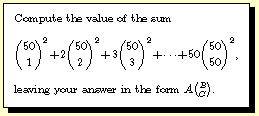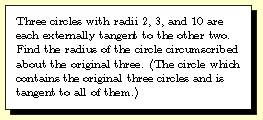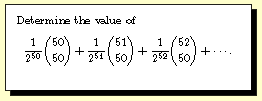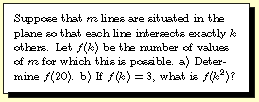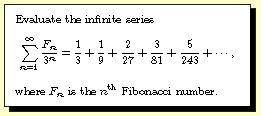... .....
|
Past Corner Problems: 1999 |
|
......
![]()
|
The Problems: |
The Solvers: |
|
Question 1999-1 |
...... |
|
Question 1999-2 |
......
|
|
Question 1999-3 |
...... |
|
Question 1999-4 |
...... |
|
Question 1999-5 |
...... |
|
Question 1999-6 |
...... |
|
Question 1999-7 |
......
|
|
Question 1999-8 |
......
|
ANSWERS TO 1999
PROBLEMS
Question 1999-1
-- there are two possibilities: either M=6 or M=-6/19.
Thanks to Steven Sivek of Thomas Jefferson who spotted this
one as an exercise in Polya's classic book, How to Solve
It.
Question 1999-2 -- the sum
is 25 C(100,50), i.e. A=25, B=100, and C=50.
Question 1999-3 -- the
circumradius is R=15. (Hint: the triangle formed by the
centers of the three original circles is a right triangle.)
Now show that the radius of the small circle nestled between
the others and tangent to all three is r=15/29.
Question 1999-4 -- the
sum is 2, which can be proved by induction or by using the
power series expansion for 1/(1-x)^51.
Question 1999-5 -- a)
3sqrt(2)/2 b) 9/2 c) 1/8 Along with his solution the
proposer included the interesting observation that the roots
of the equation are 1+sin(10), 1+sin(50), and 1-sin(70),
where the angles are measured in degrees. Can you verify
this fact?
Question 1999-6 -- in
general f(k) equals the number of divisors of k, so the
answers are a) f(20)=6 and b) f(k^2)=5
Question 1999-7 -- the
total sum is 3/5. One neat approach is to let S be the sum,
then compute 9S-3S-S using the Fibonacci recursion to
simplify the result.
Question 1999-8 -- one
quickly conjectures that the product is the square root of
three after multiplying them out on a calculator. The proof
is left to the reader.
......


